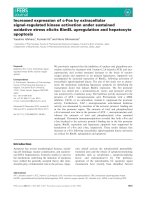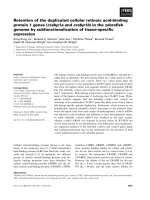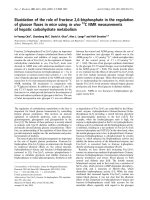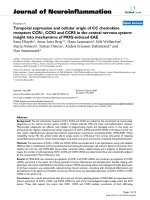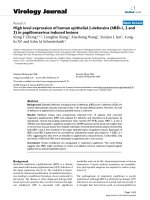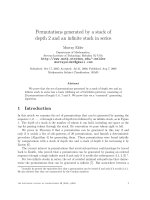Enhanced expression of sodium hydrogen exchanger (NHE)-1, 2 and 4 in the cervix of ovariectomised rats by phytoestrogen genistein
Bạn đang xem bản rút gọn của tài liệu. Xem và tải ngay bản đầy đủ của tài liệu tại đây (2.91 MB, 10 trang )
Int. J. Med. Sci. 2015, Vol. 12
Ivyspring
International Publisher
468
International Journal of Medical Sciences
Research Paper
2015; 12(6): 468-477. doi: 10.7150/ijms.11210
Enhanced Expression of Sodium Hydrogen Exchanger
(NHE)-1, 2 and 4 in the Cervix of Ovariectomised Rats
by Phytoestrogen Genistein
Nurain Ismail1, Nelli Giribabu1, Sekaran Muniandy2 and Naguib Salleh1
1.
2.
Dept of Physiology, Faculty of Medicine, University of Malaya, 50603 Lembah Pantai, Kuala Lumpur, Malaysia.
Dept of Molecular Medicine, Faculty of Medicine, University of Malaya, 50603 Lembah Pantai, Kuala Lumpur, Malaysia.
Corresponding author: E-mail: ; Tel.: +6-017-208-271; Fax: +6-03-7967-4775
© 2015 Ivyspring International Publisher. Reproduction is permitted for personal, noncommercial use, provided that the article is in whole, unmodified, and properly cited.
See for terms and conditions.
Received: 2014.11.30; Accepted: 2015.04.07; Published: 2015.06.02
Abstract
Restoring the pH of cervicovaginal fluid is important for the cervicovaginal health after menopause.
Genistein, which is a widely consumed dietary health supplement to overcome the
post-menopausal complications could help to restore the cervicovaginal fluid pH. We hypothesized that genistien effect involves changes in expression of NHE-1, 2 and 4 proteins and mRNAs
in the cervix. This study investigated effect of genistein on NHE-1, 2 and 4 protein and mRNA
expression in the cervix in order to elucidate the mechanisms underlying possible effect of this
compound on cervicovaginal fluid pH after menopause. Methods: Ovariectomised adult female rats
received 25, 50 and 100 mg/kg/day genistein for seven consecutive days. At the end of the
treatment, animals were sacrificed and cervix was harvested. Expression of Nhe-1, 2 and 4 mRNA
were analyzed by Real-time PCR while distribution of NHE-1, 2 and 4 protein were observed by
immunohistochemistry. Results: Treatment with 50 and 100 mg/kg/day genistein caused marked
increase in the levels of expression and distribution of NHE-1, 2 and 4 proteins in the endocervical
epithelia. Levels of Nhe-1, 2 and 4 mRNA in the cervix were also increased. Coadministration of
ICI 182 780 and genistein reduced the expression levels of NHE-1, 2 and 4 proteins and mRNAs in
the cervix. Conclusions: Enhanced expression of NHE-1, 2 and 4 proteins and mRNAs expression
in cervix under genistein influence could help to restore the cervicovaginal fluid pH that might help
to prevent cervicovaginal complications related to menopause.
Key words: genistein, NHE-1, 2 and 4, cervix
Introduction
Phytoestrogen genistein, which can be found in
soy-based food products, is widely consumed as a
health supplement by the post-menopausal women
[1]. Genistein has been proven useful in reducing the
risk of cardiovascular diseases after menopause [2],
protects against post-menopausal osteoporosis [3],
relieves post-menopausal symptoms such as hot
flushes [4] and overcoming post-menopausal female
reproductive complications such as altered cervical
and vaginal fluid pH, vaginal dryness and cervical
atrophy [1]. Despite of these health benefits,
over-consumption of genistein could predispose the
uterus to neoplasia [5] and triggers deranged development of the female reproductive tract in fetus [6].
The effect of genistein is mainly attributed to its ability to bind to estrogen receptor [7], which made this
compound an alternative treatment to alleviate
post-menopausal complications related to estrogen
deficiency.
Cervix, which connects vagina and the uterus,
functions to restore the sperm prior to entry into the
uterine lumen [8]. Cervix produces mucus which
consistency changes throughout the female reproductive cycle. pH of the cervical secretion changes
Int. J. Med. Sci. 2015, Vol. 12
throughout the cycle, being high before ovulation due
to increased in HCO-3 content [9]. The alkaline cervical
fluid pH is necessary for sperm capacitation [10] and
aids in the expansion of polyanionic macromolecular
mucins, [9]. pH of the cervical fluid may influence the
vaginal fluid pH. Genistein, which shares similar
characteristics to estrogen could help to restore the
cervical fluid pH after menopause, thus this could
influence the vaginal fluid pH. As the results, the
overall effect of genistein on cervicovaginal fluid pH
could help to reduce the cervicovaginal complications
related to estrogen deficiency.
Sodium-proton exchanger (NHE), which is involved in the H+ flux across the absorptive and secretory epithelia has been reported to participate in
H+ secretion that aid in reabsorption of HCO3− in the
kidney’s ascending loop of Henle [11]. NHE-2 and
NHE-3 was found to participate in Na+ reabsorption
in exchanged with H+ secretion during acidification of
the epididymal fluid. NHE has also been proposed to
participate in uterine fluid pH regulation under the
estrogen influence [12]. The mechanisms by which
NHE might be involved in increasing the pH of uterine fluid are not fully understood, however this
membrane transporter could help to ensure a continuous HCO3- secretion into the lumen by facilitating
HCO3-regeneration in the epithelial cells. In view that
genistein has been shown to cause increased in uterine fluid pH [13], therefore this compound might directly or indirectly affect the cervical NHE expression
and activity. Currently, the effect of genistein on cervical fluid pH is unknown. We hypothesized that
genistein could affect expression of NHE in the cervix
that might contribute towards restoration of cervical
fluid pH which could indirectly influence the vaginal
fluid pH. This study therefore investigated effect of
genistein on NHE-1, 2 and 4 expression (similar
isoforms expressed in the uterus) in the cervix of
ovariectomised rats represents post-menopause
model. Changes in expression of these isoforms under
genistein influence could explain ability of this compound to restore the cervicovaginal fluid pH after
menopause.
Materials and methods
Animals and hormones treatment
Adult female Sprague-Dawley (SD) rats weighing 200 - 225 g were obtained from Animal House,
Faculty of Medicine, University of Malaya and were
kept in a clean and well ventilated environment:
temperature was kept 23 ± 2 C with 12 h light: 12 h
dark cycle and 30 - 70% humidity. The animals had
free access to soy-free diet (Harlan, Germany) and tap
water ad libitum. All experimental procedures were
469
approved by the Faculty of Medicine ethics committee
with ethics number: 2013-07-15/FIS/R/NS. Genistein
was purchased from LC laboratories (Woburn, MA,
USA) with 99% purity. All other chemicals were of
analytical grades. Ovariectomy was performed under
isoflurane anesthesia two weeks prior to the treatment
to remove the effect of endogenous sex-steroids. The
rats were given intramuscular injection of 0.1 ml
kombitrim antibiotic to prevent post-surgical wound
infection. Animals were divided into the following
groups (n=6 per groups):
Group 1: seven days treatment with peanut oil
(control)
Group 2, 3 & 4: seven days treatment with 25, 50
and 100 mg/kg/ day genistein respectively
Additional groups received estrogen receptor
blocker (ICI 182 780) only or 100 mg/kg/day
genistein with ICI 182 780
A day after the last treatment, animals were sacrificed via cervical dislocation. Abdominal cavity was
cut open and cervix was removed for tissue analyses.
Quantification of Nhe-1, 2, and 4 isoforms
mRNA by Real Time PCR
Tissues were rinsed with 0.1% phosphate buffer
and kept in RNALater solution (Ambion, Austin, TX,
USA). Total RNAs were extracted by using RNeasy
plus Mini Kit (Qiagen, Hilden, Germany) with their
purity and concentration were assessed by determining the 260/280 UV absorption ratios (Gene Quant
1300, UK). The extracted RNAs were run on agarose
gel to check for their integrity. RNAs were reversely
transcribed into cDNA using a high capacity
RNA-to-cDNA kit (Applied Biosystems, USA). One
step Real Time PCR was performed to evaluate gene
expression
with
the
application
of
TaqMan®RNA-to-CT 2-Step Kit. The amplified region of
cDNA was probed with a fluorescence-labeled probe.
Gapdh was used as reference or house-keeping gene as
its expression was the most stable in the endometrium
throughout the oestrus cycle [14].
PCR program included 15 min, 48 C reverse
transcriptase, 10 min, 95 C activation with ampliTaq
gold DNA polymerase, denaturing at 95 C, 15s and
annealing at 60 C for 1 min. Denaturing and annealing
were performed for 40 cycles. Measurements were
normalized with GenEx (MultiD, Sweden) followed
by Data Assist v3 (Applied Biosystems, USA) software. The latter was used to calculate the RNA fold
changes. All experiments were carried out in triplicates. TaqMan® primers and probes were obtained
from pre-designed assays (Applied Biosystems, USA)
with Nhe- 1, 2 and 4 assay numbers are Rn01418250,
Rn006888610 and Rn01437220-m1 respectively while
the assay number for Gapdh is Rn99999916-s. Data was
Int. J. Med. Sci. 2015, Vol. 12
analyzed according to Comparative Ct (2−ΔΔCt)
method. Relative quantity of the target in each sample
was determined by comparing the normalized target
quantity of genes to normalized target quantity of
reference.
Immunoperoxidase and immunofluorescence
detection of NHE-1, 2 and 4 isoforms protein
Cervix were fixed in 10% formalin overnight
prior to processing and dehydrated through increasing concentrations of ethanol, cleared in chloroform
and blocked in paraffin wax. Tissues were then sectioned into 5 µm thicknesss, deparaffinized in xylene,
rehydrated in reducing concentrations of ethanol.
Tri-EDTA buffer (10mM Tris Base, 1mM EDTA solution, 0.05% Tween 20, pH 9.0) was used for antigen
retrieval. 1% H2O2 in methanol was used to neutralize
the endogenous peroxidase. Sections were blocked in
donkey serum (sc-2044) to prevent non-specific antibody binding prior to incubation with goat polyclonal
NHE-1 (sc-33325), NHE-2 (sc-16099) and NHE-4
(sc-16104) primary antibodies (Santa Cruz Biotechnology, CA, USA) at a dilution of 1:100 in blocking
serum. Sections were then incubated at 4 C overnight.
24 h later, the sections were rinsed three times in PBS,
five min each and incubated with biotinylated secondary antibody for 1 h at room temperature. Localization
of
proteins
was
made
by
DAB
(3,3'-Diaminobenzidine) (Santa Cruz, CA, USA)
staining, which gave dark-brown stains at the site of
the binding of primary antibody linked to secondary
antibody conjugated with HRP complex (Immunocruz, ABC staining system, Santa Cruz, CA,
USA). The sections were rinsed five min each with
deionized water and counterstained with hematoxylin to visualize the nuclei. The slides were dehydrated
with different dilution of ethanol and xylene and were
covered with a drop of DPX neutral mounting medium (Labchem Inc, Georgetown, ON, USA).
For immunofluorescence staining, the sections
were blocked in 10% normal donkey serum (Sc-2044)
(Santa Cruz Biotechnology, CA, USA) prior to incubation with NHE-1, 2 and 4 primary antibodies at
dilution as above (Santa Cruz Biotechnology, CA)
with 1.5% normal blocking serum at room temperature for one h. After three times rinsing with PBS, the
sections were incubated with IgG-fluorochromeconjugated donkey anti-goat secondary antibody
(Sc-2024) (Santa Cruz Biotechnology, CA, USA) at a
dilution of 1:250 in PBS with 1.5% normal blocking
serum at room temperature for 45 min. The slides
were rinsed three times with PBS and were mounted
with Ultracruz mounting medium (Santa Cruz Biotechnology, CA, USA). The slides were counterstained
to visualize the nuclei.
470
Evaluation of immunoperoxidase and
immunofluorescence staining intensity
The slides were viewed under Nikon Eclipse 80i
microscope (SEO Enterprises Inc, Lakeland, FL, USA)
with attached Nikon DS Ri1 12 megapixel camera
(Nikon, Tokyo, Japan). Immunoperoxidase and immunofluoresence images were captured under
standardized condition of illumination. The photographs were taken at a fixed exposure time. The tiff
images (1280 × 1024 pixels) were taken at objective
lens magnification of 40×. By using NIS-Element AR
program (Nikon Instruments Inc, Melville, NY, USA),
the exposure time and sensitivity were set prior to
image capturing. Slide with no tissue (blankfield) was
viewed under the microscope and an auto white balance was performed. Areas of interest on the images
were selected and total counts (spots with dark-brown
stained/ fluorescence signals) were obtained. The
mean intensity of dark brown stain/ signals (which
could be restricted) was determined which represents
the average amount of protein in the tissues. Average
intensity was obtained from four different sections of
four different rats receiving similar treatment.
Statistical analyses
Statistical differences were evaluated by
one-way ANOVA. A probability level of less than 0.05
(p<0.05) was considered as significant. Post‐hoc statistical power analysis was performed for all experiments and values were > 0.8 which indicate adequate
sample size. Meanwhile, Shapiro-Wilk test was performed and all values obtained were >0.05 which indicate data normality. For mRNA quantification,
mean value for each group was obtained from six (6)
rats while for protein expression and histology, mean
value for each group was obtained from four (4) rats.
Results
Distribution of NHE-1 protein in endocervix
Figures 1a and 2a show distribution of NHE-1 in
endocervical epithelia of genistein-treated ovariectomised rats. NHE-1 protein was highly distributed at
the apical membrane of epithelia lining the endocervical lumen in 50 and 100 mg/kg/day genistein
treated rats as compared to control. Lower signals/
staining were observed in rats which received 25
mg/kg/day genistein treatment as compared to 50
and 100mg/kg/day genistein treatments.
Distribution of NHE-2 protein in endocervix
Figures 3a and 4a show distribution of NHE-2
protein in endocervical epithelia of genistein-treated
ovariectomised rats. The highest NHE-2 protein distribution was observed in rats which received 50 and
Int. J. Med. Sci. 2015, Vol. 12
100 mg/kg/day genistein treatments. Low distribution was observed in rats which received 25
mg/kg/day genistein treatment.
Distribution of NHE-4 protein in endocervix
Figures 5a and 6a show distribution of NHE-4
protein in the luminal epithelia of endocervix in
genistein-treated ovariectomised rats. The distribution was the highest at the apical membrane of endocervical epithelia of 50 and 100 mg/kg/day
genistein-treated rats. Lower distribution was observed in rats which received 25 mg/kg/day
genistein treatment as compared to 50 and
100mg/kg/day genistein treatments.
Levels of expression of NHE-1, 2 and 4 protein
in the luminal epithelia of endocervix
Quantitative analyses of fluorescence signals
(figure 1b, 3b and 5b) and dark-brown staining (figure
2b, 4b and 6b) revealed that the highest levels of expression of NHE-1, 2 and 4 protein were observed in
the luminal epithelia of the endocervix of 100
mg/kg/day genistein treated rats, followed by
50mg/kg/day genistein-treated rats. Low levels of
expression was observed in rats receiving 25
mg/kg/day genistein treatment.
471
Expression levels of Nhe-1, 2 and 4 mRNA in
cervix
Figure 7 shows the levels of expression of Nhe-1,
2 and 4 mRNAs in cervical tissue homogenates of
ovariectomized rats receiving genistein treatment.
The levels of expression of NHE-1, 2 and 4 mRNAs
were the highest in cervix of rats which received 100
mg/kg/day genistein treatment. Significantly lower
mRNA expression levels were observed following 50
and 25 mg/kg/day genistein treatments (p<0.05 as
compared to 100 mg/kg/day genistein treatment).
The levels of mRNA expression in 25mg/kg/day
genistein treated rats were higher than control.
Effects of ICI 182780 on NHE-1, 2 and 4
protein distribution and expression
Figure 8a shows distribution of NHE-1, 2 and 4
proteins in endocervical epithelia while figure 8b
shows quantitative analysis of the intensity of fluorescence signals in rats receiving 100 mg/kg/day
genistein with or without ICI 182 780 treatment. Our
findings indicated that the intensity of fluorescence
signals was significantly reduced following concomitant 100 mg/kg/day genistein and ICI 182 780 treatment as compared to 100mg/kg./day genistein-only
treatment.
Figure 1: (a) Immunofluorescence images of NHE-1 in cervix. High intensity signals were seen at apical membrane of endocervical epithelia under 100 mg/kg/day genistein. Lower
signals were seen at apical membrane of endocervical epithelia following treatment with 50 and 25 mg/.kg/day genistein (b) Quantitative analyses of fluorescence signals for NHE-1 in
endocervical epithelia under genistein influence. The fluorescence signal intensity was highest in 100 mg/kg/day genistein treated group. Signal intensity in all groups of treatment was
higher than control. C: control, 25G: 25 mg/kg/day genistein, 50G: 50 mg/kg/day genistein, 100G: 100 mg/kg/day genistein. Arrows pointing toward NHE-1. † p<0.05 as compared to C. scale
bar: 50 µm
Int. J. Med. Sci. 2015, Vol. 12
472
Figure 2: (a) Immunoperoxidase images of NHE-1 distribution in cervix. High intensity dark-brown staining could be seen at the apical membrane of endocervical epithelia in 50 and
100 mg/kg/day genistein treatment groups. Mild staining was seen in 25 mg/kg/day genistein treatment group. (b) Quantitative analyses of peroxidase staining for NHE-1 in endocervical epithelia. The intensity of peroxidase staining was the highest in 100 mg/kg/day genistein treatment group. Staining intensity in all groups was higher than control. C: control, 25G:
25 mg/kg/day genistein, 50G: 50 mg/kg/day genistein, 100G: 100 mg/kg/day genistein. Arrows pointing toward NHE-1. † p<0.05 as compared to C. scale bar: 50 µm
Figure 3: (a) Immunofluorescence images of NHE-2 distribution in cervix. High intensity fluorescence signals were observed at the apical membrane of endocervical epithelia in 100
mg/kg/day genistein treatment group. Moderate signal was seen in 25 and 50 mg/kg/day genistein treatment groups. (b) Quantitative analyses of fluorescence signals for NHE-2 in
endocervical epithelia under genistein influence. Fluorescence signal intensity was the highest in 100 mg/kg/day genistein treatment group. Signal intensity in all groups of treatments was
higher than control. C: control, 25G: 25 mg/kg/day genistein, 50G: 50 mg/kg/day genistein, 100G: 100 mg/kg/day genistein. Arrows pointing toward NHE-2. † p<0.05 as compared to C. scale
bar: 50 µm
Int. J. Med. Sci. 2015, Vol. 12
473
Figure 4: (a) Immunoperoxidase images of NHE-2 distribution in cervix. High intensity staining were observed at the apical membrane of endocervical epithelia in 100 and 50
mg/kg/day genistein treatment groups. (b) Quantitative analyses of peroxidase staining for NHE-2 in endocervical epithelia. The intensity of peroxidase staining was the highest in
100 mg/kg/day genistein treatment group. Staining intensity in all groups was higher than control. C: control, 25G: 25 mg/kg/day genistein, 50G: 50 mg/kg/day genistein, 100G: 100 mg/kg/day
genistein. Arrows pointing toward NHE-2 isoform. † p<0.05 as compared to C. scale bar: 50 µm
Figure 5: (a) Immunofluorescence images of NHE-4 distribution in cervix. High intensity signals could be seen at the apical membrane of endocervical epithelia in 50 and 100
mg/kg/day genistein treatment groups. (b) Quantitative analyses of fluorescence signals for NHE-4 in endocervical epithelia under genistein influence. Fluorescence signal
intensity was the highest in 100 mg/kg/day genistein treatment group. Signal intensity in all groups of treatment was higher than control. C: control, 25G: 25 mg/kg/day genistein, 50G: 50
mg/kg/day genistein, 100G: 100 mg/kg/day genistein. Arrows pointing toward NHE-4 isoform. † p<0.05 as compared to C. scale bar: 50 µm
Int. J. Med. Sci. 2015, Vol. 12
474
Figure 6: (a) Immunoperoxidase images of NHE-4 distribution in cervix. High intensity staining were observed at the apical membrane of endocervical epithelia in 100 and 50
mg/kg/day genistein treatment groups. (b) Quantitative analyses of peroxidase staining for NHE-4 in endocervical epithelia. The intensity of peroxidase staining was the highest in
100 mg/kg/day genistein treatment group. Staining intensity in all groups was higher than control C: control, 25G: 25 mg/kg/day genistein, 50G: 50 mg/kg/day genistein, 100G: 100 mg/kg/day
genistein. Arrows pointing toward NHE-4. † p<0.05 as compared to C. scale bar: 50 µm
Figure 7: Expression of NHE-1, 2 and 4 mRNA in the cervix of genistein-treated ovariectomised rats. The highest mRNA levels for NHE-1, 2 and 4 were noted in 100 mg/kg/day
genistein treatment group. C: control, 25G: 25 mg/kg/day genistein, 50G: 50 mg/kg/day genistein, 100G: 100 mg/kg/day genistein † p<0.05 as compared to C.
Effect of ICI 182780 on NHE-1, 2 and 4 mRNA
expression
Figure 9 shows levels of expression of NHE-1, 2
and 4 mRNAs in the cervical tissue homogenates of
rats receiving 100 mg/kg/day genistein with or
without ICI 182 780. Our findings indicated that administration of ICI 182780 in 100mg/kg/day genistein
treated rats significantly reduced the levels of expression all three NHE isoforms mRNAs as compared to
100mg/kg/day genistein-only treatment.
Int. J. Med. Sci. 2015, Vol. 12
475
Figure 8: (a) Effect of ICI 182780 on distribution of NHE-1, 2 and 4 protein in cervix (b) Intensity of fluorescence signal in endocervical epithelium. Distribution and
expression levels of NHE-1, 2 and 4 proteins in endocervical epithelia were markedly reduced in the group which received concomitant 100 mg/kg/day genistein and ICI 182780 treatment. No
significant difference was noted between ICI 182780 only treatment and control. 100G: 100 mg/kg/day genistein. Arrows pointing toward NHE. * p<0.05 as compared to C. † p<0.05 as
compared to 100G+ICI 182780.
Figure 9: Effect of ICI 182780 on NHE-1, 2 and 4 mRNA levels in cervical tissue homogenates. Expression of NHE-1, 2 and 4 mRNA was significantly reduced in rats receiving
concomitant 100 mg/kg/day genistein and ICI 182 780 treatment as compared to 100 mg/kg/day genistein-only treatment. No significant difference was noted between ICI 182780-only
treatment and control. 100G: 100 mg/kg/day genistein. * p<0.05 as compared to C. † p<0.05 as compared to 100G+ICI 182780.
Int. J. Med. Sci. 2015, Vol. 12
Discussion
This study has confirmed genistein upregulation
of NHE isoforms expression in the cervix of rats that
might contribute towards the beneficial effect of this
compound in preventing cervicovaginal complications after menopause as a result of altered cervicovaginal fluid pH. We have shown that administration of genistein at 50 and 100 mg/kg/day could enhance the expression of NHE-1, 2 and 4 in the cervix
of sex-steroid deficient rats involving the estrogen
receptor mediated pathway. Restoring the pH of cervical fluid could prevent pathologies in the cervix and
vagina as alteration in cervical fluid pH might predispose cervix to pre-malignant changes, therefore
increasing the risk of carcinoma [15]. Additionally,
restoring the pH of the cervical fluid could help to
restore the pH of vaginal fluid, that is essential for
maintaining equilibrium of the vaginal flora [16]. This
could prevent vaginal infection which is one of the
most frequent complication of menopause [17].
Cervix is a sex-steroid responsive organ that responses to estrogen treatment. Estrogen stimulates
increased in cervical fluid secretion [18], Both estrogen and progesterone affect the consistency of cervical
mucus [8]. Estrogen has been shown able to influence
the membrane transport processes in human cervical
cell line in culture [19] and induces increase in cervical
HCO3- secretion which contributed towards the alkaline cervical fluid pH [8]. Genistein, which is structurally related to estrogen and is widely consumed as
a health supplement by the post-menopausal women
was reported able to increase the pH of uterine fluid
in post-menopausal rat model [13]. In view of this,
there is a possibility that genistein could affect the
cervical fluid pH. In this study, there were evidences
that genistein could affect the pH of cervical fluid in
view that it was able to upregulate the expression of
NHE isoforms 1, 2 and 4 in the epithelia lining the
endocervical lumen. Increased in apical membrane
expression of NHE could either help to increase the
excretion of H+ or to continuously maintain the excretion of HCO3- into the cervical lumen. This however
warrants further investigations.
The involvement of NHE in the regeneration of
HCO3- has been shown in the kidney [20] where high
levels of NHE expression has been reported at the
apical membrane which mediate H+ efflux that could
neutralize the HCO3- in the tubular fluid [20]. As
proposed in the kidneys and uterus, H+ will combine
with HCO3- to form H2CO3 through the action of
transmembrane carbonic anhydrase [21]. H2CO3 will
then dissociates into CO2 and H2O which diffuse into
the cells to form H2CO3 through the action of intracellular carbonic anhydrase [21]. Within the cells,
H2CO3 will dissociate into H+ and HCO3-. In the kid-
476
neys, HCO3- is reabsorbed into the plasma via basolateral membrane HCO3- transporters [22], while, in
uterus, high expression of HCO3- transporters or examples CFTR [7] and SLC26A6 [13] at the apical
membrane of the endometrial luminal epithelia assist
in HCO3- extrusion into the lumen. [22] There is a
possibility that H+ excreted in the uterus through
NHE might assist in HCO3- recycling that ensure continuous supply of HCO3- uterine lumen [13]. We
speculated that similar mechanisms could occur in the
cervix in which upregulation of NHE 1, 2 and 4 expression at the apical membrane of endocervical epithelia might help to ensure the continuous supply of
HCO3- into the cervical lumen. Alternatively, increased expression of NHE-1, 2 and 4 might also help
to enhance H+ extrusion into the cervical lumen which
contributed towards the reduction in cervical fluid
pH. Further studies are needed to confirm changes in
the cervical fluid pH under genistein influence that
could support either one of these possibilities. In the
case that NHE enhances H+ extrusion into the cervical
lumen, reduction in cervical fluid pH could influence
the pH of the vaginal fluid. High H+ content could
result in low vaginal fluid pH which could reduce the
risk of vaginal infection after menopause [23]. The
involvement of cervical NHE in vaginal fluid acidification could compliment the direct role of V-ATPase
in mediating acidification of the vaginal fluid under
estrogen or compounds with estrogenic effect [24].
The two possible consequences of genistein effect on
the cervix are summarized in figure 10.
Figure 10: Hypothetical diagram showing the involvement of NHE isoforms in
mediating possible effect of genistein on cervical and vaginal fluid pH. Genistein
binds to ER prior to inducing transcription of NHE-1, 2 and 4 genes in the cervix. This leads
to increased expression of NHE-1, 2 and 4 proteins at the apical membrane of endocervical
epithelia. NHE mediates H+ extrusion into the cervical lumen. The extruded H+ could either
decrease the cervical pH which lead to a parallel decrease in vaginal pH. Alternatively,
extruded H+ can combine with HCO3-, which levels presumably increase under genistein
influence through CFTR and SLC26A6 channels at the apical membrane. H+ will combine
with HCO3- to form H2CO3 which through the action of transmembrane CA, will generates
CO2 and H2O. CO2 and H2O traverse the apical membrane and will be reconverted to H+
and HCO3- via the action of intracellular CA.. ER: estrogen receptor, NHE: sodium proton
exchanger, CFTR: cystic fibrosis transmembrane regulator, SLC26A^: chloride bicarbonate
exchanger, SLC4A4: sodium bicarbonate cotransporter, CA: carbonic anhydrase.
Int. J. Med. Sci. 2015, Vol. 12
We concluded that enhanced expression of NHE
1, 2 and 4 isoforms in the endocervival epithelia could
help to restore the cervicovaginal fluid pH after
menopause. This might help to reduce the cervicovaginal complications related to menopause [25].
Acknowledgement
This study was funded by UMRG Grant
(RG314-14AFR) University of Malaya, Kuala Lumpur,
Malaysia.
Conflict of interest
The authors reported no conflict of interest in
this study.
References
1.
2.
3.
4.
5.
6.
7.
8.
9.
10.
11.
12.
13.
14.
15.
16.
17.
18.
477
19. Gorodeski GI. Estrogen increases the permeability of the cultured human
cervical epithelium by modulating cell deformability. American Journal of
Physiology-Cell Physiology 1998; 275(3): C888-C899
20. Ford P, Rivarola V, Kierbel A, Chara O. Blot-Chabaud M, Farman N, Parisi M,
Capurro C, Differential role of Na+/H+ exchange isoforms NHE-1 and NHE-2
in a rat cortical collecting duct cell line. The Journal of membrane biology 2002;
190(2): 117-125
21. Gholami K, Muniandy S, Salleh N. In-Vivo Functional Study on the
In-volvement of CFTR, SLC26A6, NHE-1 and CA Isoenzymes II and XII in
Uterine Fluid pH, Volume and Electrolyte Regulation in Rats under Different
Sex-Steroid Influence. International journal of medical sciences 2013; 10(9):
1121
22. Hou J, Rajagopal M, Alan S. Claudins and the Kidney Volume 75: Annual
Review of Physiology. Annual review of physiology 2013; 75(): 479
23. Boskey E, Telsch K, Whaley K, Moench T, Cone R. Acid production by vaginal
flora in vitro is consistent with the rate and extent of vaginal acidifi-cation.
Infection and immunity 1999; 67(10): 5170-5175
24. Gorodeski GI, Hopfer U, Liu CC, Margles E. Estrogen Acidifies Vaginal pH by
Up-Regulation of Proton Secretion via the Apical Membrane of Vagi-nal-Ectocervical Epithelial Cells. Endocrinology 2005; 146(2): 816-824
25. Bulten J, de Wilde P, Schijf C, van der Laak JA, Wienk S, Poddighe PJ, Hanselaar AG. Decreased expression of Ki‐67 in atrophic cervical epithelium of
post‐menopausal women. The Journal of pathology 2000; 190(5): 545-553
Cassidy A, Albertazzi P, Nielsen IL, Hall W, Williamson G, Tetens I, Atkins S,
Cross H, Manios Y, Wolk A. Critical review of health effects of soyabean
phyto-oestrogens in post-menopausal women. Proceedings of the Nutrition
Society 2006; 65(01): 76-92
Squadrito F, Altavilla D, Morabito N, Crisafulli A, D'Anna R, Corrado F,
Ruggeri P, Campo GM, Calapai G, Caputi AP. The effect of the phytoestrogen
genistein on plasma nitric oxide concentrations, endothelin-1 levels and endothelium dependent vasodilation in postmenopausal women. Atherosclerosis 2002; 163(2): 339-347
Morabito N, Crisafulli A, Vergara C, Gaudio A, Lasco A, Frisina N, D'Anna R,
Corrado F, Pizzoleo MA, Cincotta M. Effects of Genistein and Hormone‐Replacement Therapy on Bone Loss in Early Postmenopausal Women:
A Randomized Double‐Blind Placebo‐Controlled Study. Journal of Bone and
Mineral Research 2002; 17(10): 1904-1912
Crisafulli A, Marini H, Bitto A, Altavilla D, Squadrito G, Romeo A, Adamo EB,
Marini R, D'Anna R, Corrado F. Effects of genistein on hot flushes in early
postmenopausal women: a randomized, double-blind EPT-and placebo-controlled study. Menopause 2004; 11(4): 400-404
Newbold RR, Banks EP, Bullock B, Jefferson WN. Uterine adenocarcinoma in
mice treated neonatally with genistein. Cancer Research 2001; 61(11):
4325-4328
Jefferson WN, Padilla-Banks E, Newbold RR. Disruption of the female reproductive system by the phytoestrogen genistein. Reproductive Toxicology 2007;
23(3): 308-316
Chinigarzadeh A, Kassim NM, Muniandy S, Salleh N. Genistein-induced fluid
accumulation in ovariectomised rats' uteri is associated with increased cystic
fibrosis transmembrane regulator expression. Clinics 2014; 69(2): 111-119
Johnson MH. Essential reproduction. John Wiley & Sons. 2012
Muchekehu RW, Quinton PM. A new role for bicarbonate secretion in cervico-uterine mucus release. The Journal of physiology 2010; 588(13): 2329-2342
Chan HC, Ruan YC, He Q, Chen MH, Chen H, Xu WM, Chen WY, Xie C,
Zhang XH, Zhou Z. The cystic fibrosis transmembrane conductance regulator
in reproductive health and disease. The Journal of physiology 2009; 587(10):
2187-2195
Good DW. Sodium-dependent bicarbonate absorption by cortical thick ascending limb of rat kidney. American Journal of Physiology-Renal Physiology
248.1985; 6(): F821-F829
Gholami K, Muniandy S, Salleh N. Differential expression of
Na+/H+-exchanger (NHE-1, 2, and 4) proteins and mRNA in rodent's uterus
under sex steroid effect and at different phases of the oestrous cycle. BioMed
research international 2013 (2013)
Chinigarzadeh A, Kasim NF, Muniandy S, Kassim NM, Salleh N. Genistein
Induces Increase in Fluid pH, Na+ and HCO3− Concentration, SLC26A6 and
SLC4A4 (NBCe1)-B Expression in the Uteri of Ovariectomized Rats. International journal of molecular sciences 2014; 15(1): 958-976
Lin P, Lan X, Chen F, Yang Y, Jin Y, Wang A. Reference gene selection for
real-time quantitative PCR analysis of the mouse uterus in the
pe-ri-implantation period. PloS one 2013; 8(4): e62462
No JH, Jo H, et al. Expression of Vascular Endothelial Growth Factor and
Hypoxia Inducible Factor-1α in Cervical Neoplasia. Annals of the New York
Academy of Sciences 2009;1171(1): 105-110
Murta EF, Perfeito PB, Oliveira TM, Michelin MA, Maluf PJ. Relation between
vaginal and endocervical pH in patients undergoing cold-knife conization and
hysterectomy. Arch Gynecol Obstet 2008; 277(1): 43-46
Sánchez-Borrego R, et al. Position of the Spanish Menopause Society regarding
vaginal health care in postmenopausal women. Maturitas 2014; 78(2): 146-150
Gorodeski GI. The Cultured Human Cervical Epithelium: A New Model for
Studying Paracellular Transport. Journal of the Society for Gynecologic Investigation 1996; 3(5): 267-280



